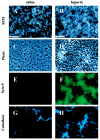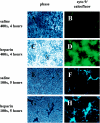Heparin stimulates Staphylococcus aureus biofilm formation
- PMID: 16040971
- PMCID: PMC1201187
- DOI: 10.1128/IAI.73.8.4596-4606.2005
Heparin stimulates Staphylococcus aureus biofilm formation
Abstract
Heparin, known for its anticoagulant activity, is commonly used in catheter locks. Staphylococcus aureus, a versatile human and animal pathogen, is commonly associated with catheter-related bloodstream infections and has evolved a number of mechanisms through which it adheres to biotic and abiotic surfaces. We demonstrate that heparin increased biofilm formation by several S. aureus strains. Surface coverage and the kinetics of biofilm formation were stimulated, but primary attachment to the surface was not affected. Heparin increased S. aureus cell-cell interactions in a protein synthesis-dependent manner. The addition of heparin rescued biofilm formation of hla, ica, and sarA mutants. Our data further suggest that heparin stimulation of biofilm formation occurs neither through an increase in sigB activity nor through an increase in polysaccharide intracellular adhesin levels. These finding suggests that heparin stimulates S. aureus biofilm formation via a novel pathway.
Figures





Similar articles
-
Catheter lock solutions influence staphylococcal biofilm formation on abiotic surfaces.Nephrol Dial Transplant. 2006 Aug;21(8):2247-55. doi: 10.1093/ndt/gfl170. Epub 2006 Apr 20. Nephrol Dial Transplant. 2006. PMID: 16627606
-
Molecular characterization of regulatory genes associated with biofilm variation in a Staphylococcus aureus strain.J Microbiol Biotechnol. 2008 Jan;18(1):28-34. J Microbiol Biotechnol. 2008. PMID: 18239412
-
Impact of oleic acid (cis-9-octadecenoic acid) on bacterial viability and biofilm production in Staphylococcus aureus.FEMS Microbiol Lett. 2008 Oct;287(2):149-55. doi: 10.1111/j.1574-6968.2008.01316.x. Epub 2008 Aug 27. FEMS Microbiol Lett. 2008. PMID: 18754790
-
Biomolecular mechanisms of staphylococcal biofilm formation.Future Microbiol. 2013 Apr;8(4):509-24. doi: 10.2217/fmb.13.7. Future Microbiol. 2013. PMID: 23534362 Review.
-
Anti-biofilm agents: recent breakthrough against multi-drug resistant Staphylococcus aureus.Pathog Dis. 2014 Apr;70(3):231-9. doi: 10.1111/2049-632X.12141. Epub 2014 Feb 24. Pathog Dis. 2014. PMID: 24453168 Review.
Cited by
-
Hyaluronan Modulation Impacts Staphylococcus aureus Biofilm Infection.Infect Immun. 2016 May 24;84(6):1917-1929. doi: 10.1128/IAI.01418-15. Print 2016 Jun. Infect Immun. 2016. PMID: 27068096 Free PMC article.
-
Effect of silver nanocoatings on catheters for haemodialysis in terms of cell viability, proliferation, morphology and antibacterial activity.J Mater Sci Mater Med. 2013 Apr;24(4):1105-12. doi: 10.1007/s10856-013-4870-0. Epub 2013 Jan 31. J Mater Sci Mater Med. 2013. PMID: 23371767
-
Use and safety of unfractionated heparin for anticoagulation during maintenance hemodialysis.Am J Kidney Dis. 2012 Sep;60(3):473-86. doi: 10.1053/j.ajkd.2012.03.017. Epub 2012 May 5. Am J Kidney Dis. 2012. PMID: 22560830 Free PMC article. Review.
-
Roles of cellular activation and sulfated glycans in Haemophilus somnus adherence to bovine brain microvascular endothelial cells.Infect Immun. 2006 Sep;74(9):5311-8. doi: 10.1128/IAI.00614-06. Infect Immun. 2006. PMID: 16926425 Free PMC article.
-
Functional amyloids from bacterial biofilms - structural properties and interaction partners.Chem Sci. 2022 May 6;13(22):6457-6477. doi: 10.1039/d2sc00645f. eCollection 2022 Jun 7. Chem Sci. 2022. PMID: 35756505 Free PMC article. Review.
References
-
- Arnow, P. M., E. M. Quimosing, and M. Beach. 1993. Consequences of intravascular catheter sepsis. Clin. Infect. Dis. 16:778-784. - PubMed
Publication types
MeSH terms
Substances
Grants and funding
LinkOut - more resources
Full Text Sources
Other Literature Sources
Medical
Research Materials
Miscellaneous

